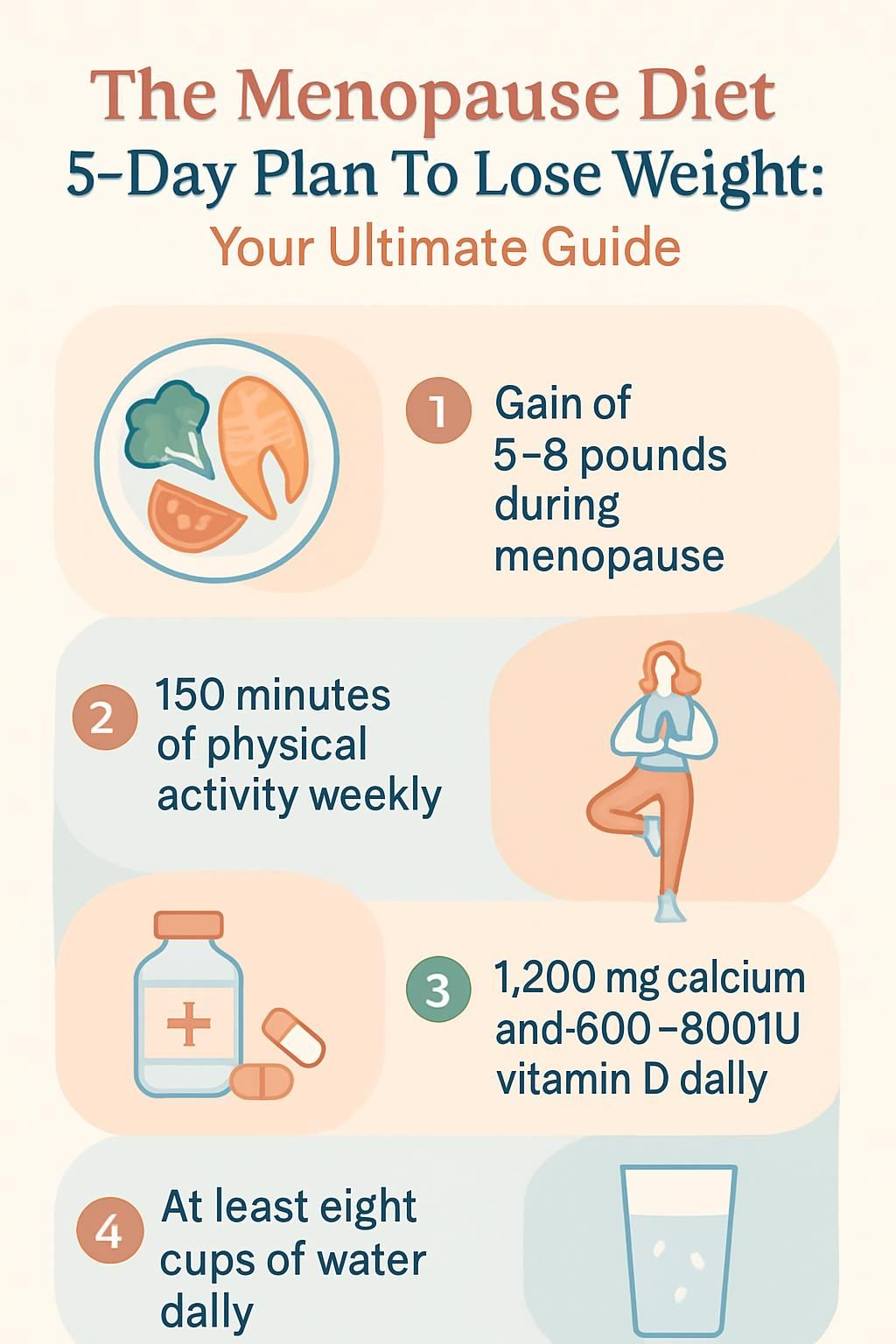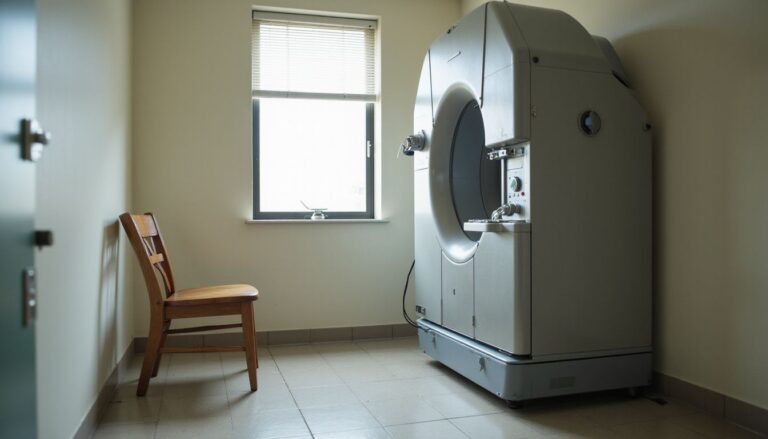The Menopause Diet 5-Day Plan To Lose Weight: Your Ultimate Guide
Our Nutrition Assistant AI Suite will transform your body. You will lose fat, get toned, and build muscle. Gain confidence and optimal health.
You may notice weight gain during menopause, and belly fat can feel stubborn. Hormone shifts at this time can slow your metabolism, which makes weight control harder. A structured menopause diet plan helps you lose weight, steady energy, and protect long-term health.
The Menopause Diet 5 Day Plan To Lose Weight gives you a simple path. In this guide, you will see key foods, smart habits, and a practical 5-day meal plan that fits real life. Use it to eat well, feel better, and stay consistent.
Start your plan today and take confident steps toward a healthier you.
Key Takeaways
- During menopause, lower estrogen slows metabolism and raises the chance of gaining 5 to 8 pounds, often around the abdomen.
- The Menopause Diet 5-Day Plan features high-fiber foods, lean protein, and healthy fats from olive oil and nuts while limiting sugar and processed foods.
- About half of women gain weight in perimenopause, according to the North American Menopause Society; soy isoflavones may ease hot flashes and support bones.
- Daily goals: at least eight cups of water, 150 minutes of weekly activity, 7 to 9 hours of sleep, and stress control for better weight outcomes.
- A diet rich in calcium, 1,200 mg per day, and vitamin D, 600 to 800 IU per day, supports bone health after menopause.

How Menopause Affects Weight Gain

Many women gain weight during menopause because of hormone and metabolism changes. Understanding how menopause drives weight gain makes it easier to build habits that work.
Why Do Women Gain Weight During Menopause?
Lower estrogen changes how your body stores fat and uses calories. Fat often shifts to the abdomen, which leads to more belly fat. Estrogen also affects how you use carbohydrates, so weight can rise even if your routine stays the same.
Age-related muscle loss slows metabolism as well. That means you burn fewer calories at rest and during daily tasks. Sleep issues and mood swings can raise cravings, late-night eating, or stress snacking, which adds more calories.
In studies published in Menopause, women in perimenopause and menopause gained an average of 5 to 8 pounds over a few years.
Declining estrogen shifts body fat distribution and slows calorie use, making weight management harder during menopause.
Regular movement and a balanced meal plan work together to counter menopause weight gain and improve health.
How Do Hormonal and Metabolic Changes Impact Weight?
Falling estrogen slows your resting metabolism and raises abdominal fat. This change means your body burns fewer calories, even with the same meals and activities. Insulin sensitivity can drop too, which raises blood sugar and the risk of type 2 diabetes.
Hormone shifts may signal your body to store more fat, making fat loss slower. Appetite hormones can also swing, which increases hunger and cravings for high-calorie foods. As muscle mass declines, daily calorie burn drops further.
Losing weight may take more planning now. Focus on higher fiber and protein, steady activity, and consistent sleep. These steps support energy and make a meaningful difference over time.
These changes explain why a balanced menopause diet plan becomes vital during this stage.
Why Is a Balanced Diet Important During Menopause?
A balanced diet gives your body steady energy and nutrients that support hormones and weight control. Eating well also helps ease common symptoms and supports focus and mood.
What Are the Benefits of Maintaining a Healthy Weight?
Healthy weight lowers the risk of heart disease, type 2 diabetes, and joint strain. Research also links a stable weight with fewer severe symptoms, such as hot flashes and poor sleep.
Extra pounds can strain joints and raise the risk for osteoporosis, a disease that weakens bones. Managing abdominal obesity improves heart and metabolic health. Good nutrition, plus regular exercise, supports hormone balance and bone strength.
After dropping 10 pounds postmenopause, I slept better and felt more confident. Small, steady changes can improve comfort and quality of life.
Which Nutrients Help Balance Hormones?
Protein supports appetite control and insulin balance. Include chicken, fish, eggs, beans, tofu, or Greek yogurt at each meal. Healthy fats from olive oil, avocado, nuts, and seeds help build hormones and may reduce mood swings.
Dietary fiber from whole grains, legumes, fruits, and vegetables slows digestion and steadies blood sugar. Calcium supports bones; choose dairy, leafy greens, or calcium-fortified plant milks. Vitamin D improves calcium absorption; get it from sunlight, fatty fish, or fortified foods when sun is limited.
Soybeans and other legumes contain isoflavones, plant compounds that act like weak estrogen. These may ease hot flashes and support bone health.
A varied diet with these nutrients supports weight loss during menopause while helping hormones stay more balanced.
Key Principles of the Menopause Diet
This plan uses simple food choices that fit your day. The goal is steady blood sugar, better appetite control, and strong nutrition.
Why Choose Slow-Digesting Foods?
Slow-digesting foods, like oats, quinoa, beans, and sweet potatoes, release energy gradually. They help you avoid sharp blood sugar spikes and dips, which reduces cravings and overeating.
Low-glycemic choices are linked with better appetite control and healthy weight during the menopause transition. Harvard Health reports that slow-releasing carbohydrates help you feel full longer and support consistent energy.
Adding one slow-digesting item to each meal, such as oats at breakfast or beans at lunch, can make daily eating feel more stable.
How Does Increasing Soluble Fiber Help?
Soluble fiber slows the digestion of carbs and helps keep blood sugar steady. Oats, apples, beans, and flaxseed are standout picks that also support gut bacteria and lower inflammation.
Women who reach at least 25 grams of fiber a day are less likely to gain weight during and after menopause. Build plates with more legumes, whole grains, and produce to hit that goal.
Fiber helps meals feel satisfying, which makes sticking to a 5-day menopause meal plan easier.
What Are the Benefits of More Protein?
Protein protects muscle, which supports your metabolism as hormones change. Lean meat, eggs, Greek yogurt, and legumes repair muscle after strength or cardio workouts. More muscle helps you burn more calories each day.
Research links higher protein intake with lower body fat and better fullness. Plan protein at every meal to steady energy and reduce snacking. If you follow a Mediterranean-style or plant-based diet, use beans, tofu, tempeh, nuts, spinach, and kale.
Protein-rich meals also support mood by leveling blood sugar swings.
How Can Isoflavones Support Menopause Health?
Isoflavones are plant compounds in soybeans, tofu, tempeh, and other legumes. They act like mild estrogen in the body, which can help as natural estrogen falls during menopause.
Studies show that about 50 mg of isoflavones daily, roughly two servings of soy foods, may reduce hot flashes and night sweats for many women^1. Some women report fewer mood swings and better sleep when they add tofu, edamame, or miso.
I replaced breakfast sausage with a tofu scramble while following a 5-day menopause diet plan. Within weeks, my sleep improved and night temperature swings eased. Research also suggests isoflavones support bone health by slowing calcium loss after menopause^2.
Choosing soy foods or chickpeas gives you extra protein and potential symptom relief at the same time.
Switching to slow-digesting foods supports blood sugar balance during this stage; learn how these choices make a difference next.
…
^1 North American Menopause Society, “Isoflavones and Menopausal Symptoms,” 2022.
^2 Journal of Nutrition, “Isoflavones Support Bone Mineral Density in Postmenopausal Women,” 2020
Why Should Sugars and Processed Foods Be Reduced?
High-sugar foods and refined grains cause quick blood glucose spikes. This leads to higher insulin, which can drive fat storage and weight gain during menopause. Sugary snacks and drinks also add calories without helping you feel full.
Processed items often pack extra salt, trans fat, and additives. These can promote water retention, inflammation, and more cravings. Diets high in sugar link to more belly fat, which raises risk for heart disease after menopause.
Reducing processed foods supports steady energy and better mood, which makes long-term weight control more likely.
What Are the Effects of Avoiding Alcohol?
Avoiding alcohol supports weight loss during menopause because alcohol adds calories fast and can boost appetite. People who skip drinks often find weight control easier.
Alcohol can also disrupt sleep, increase hot flashes, and affect mood. Choosing non-alcoholic drinks helps hydration and reduces added stress on the body. For many, fewer drinks lead to better digestion and fewer sugar cravings.
What Does a 5-Day Menopause Diet Plan Look Like?
This 5-day diet plan offers simple meals and snacks that support weight loss during menopause. Each day includes slow-digesting carbs, lean protein, healthy fats, and fiber.
What Meals and Snacks Are Recommended on Day 1?
Start with balanced meals that steady blood sugar and support hormone changes. Day 1 keeps it simple and satisfying.
- Breakfast: Greek yogurt with chia seeds and sliced berries for protein, fiber, and antioxidants.
- Snack: A small handful of almonds or walnuts for healthy fats and steady energy.
- Lunch: Large salad with leafy greens, grilled chicken, cherry tomatoes, chickpeas, olive oil, and lemon.
- Snack: Carrot sticks with hummus to add soluble fiber and support blood sugar control.
- Dinner: Grilled salmon with sautéed spinach, brown rice, and roasted red peppers.
- Optional evening snack: Air-popped popcorn or one fresh fruit like an apple.
- Hydration: Aim for at least eight cups of water across the day.
Continue to Day 2 to keep progressing with your plan for menopause.
What Meals and Snacks Are Recommended on Day 2?
Day 2 focuses on fiber, lean protein, and steady energy. Keep portions moderate and enjoy balanced flavors.
- Breakfast: Whole grain toast with nut butter and sliced banana for fiber and healthy fats.
- Snack: Greek yogurt with fresh berries for protein and antioxidants.
- Lunch: Mixed greens with grilled chicken, chickpeas, olive oil, and lemon juice.
- Snack: Raw carrots or bell pepper strips with hummus to support gut health.
- Dinner: Grilled salmon or tofu with steamed broccoli and quinoa for protein and complex carbs.
- Evening snack: Cottage cheese with chopped walnuts to add protein, calcium, and healthy fat.
- Hydration: At least eight glasses of water to support metabolism and digestion.
What Meals and Snacks Are Recommended on Day 3?
Day 3 brings a mix of complex carbs, lean protein, and healthy fats to keep you satisfied.
- Breakfast: Steel-cut oats with chopped nuts and berries for fiber and steady energy.
- Snack: Cottage cheese with fresh pineapple for calcium and protein.
- Lunch: Grilled salmon over quinoa salad for protein and omega-3s.
- Snack: Pistachios or raw veggies with hummus for soluble fiber.
- Dinner: Baked chicken breast with steamed broccoli and a sweet potato.
- Evening snack: Greek yogurt topped with chia seeds to support fullness overnight.
- Hydration: Aim for eight cups of water during the day.
With Day 3 complete, keep momentum with simple lifestyle habits that support weight control.
What Meals and Snacks Are Recommended on Day 4?
Day 4 centers on mood support and steady energy. Choose meals rich in protein, fiber, and vitamins.
- Breakfast: Greek yogurt with berries and ground flaxseed for protein, calcium, and omega-3s.
- Snack: An apple with almond butter for fiber and healthy fat.
- Lunch: Grilled chicken over quinoa with steamed broccoli and bell peppers for protein and vitamins.
- Snack: Carrot sticks or cherry tomatoes with hummus for plant-based protein and antioxidants.
- Dinner: Baked salmon with brown rice and asparagus for omega-3s and vitamin D support.
- Evening snack: Cottage cheese with sliced peaches to boost calcium intake.
- Hydration: Eight cups of water to support metabolism and digestion.
These meals favor whole foods and limit added sugars, which helps you manage body shape with evidence-based choices.
What Meals and Snacks Are Recommended on Day 5?
Day 5 completes the plan with nutrient-dense meals that help manage weight and support hormones.
- Breakfast: Steel-cut oats topped with chia seeds, blueberries, and walnuts for soluble fiber and healthy fats.
- Snack: Low-fat Greek yogurt with sliced strawberries for protein and vitamin C.
- Lunch: Grilled salmon over quinoa with steamed broccoli and cherry tomatoes.
- Snack: Baby carrots with hummus for fiber and plant protein.
- Dinner: Roasted turkey breast with mashed sweet potato and sautéed spinach in olive oil.
- Evening snack: Sliced apple or pear with cinnamon for a lightly sweet option.
- Hydration: Keep water intake near eight cups through the day.
After finishing this 5-day plan, I felt less bloated and more energized. Pairing meals with daily walks made the changes stick.
How Can Lifestyle Changes Support Weight Loss?
Daily habits shape your results. Small actions add up, especially when hormones are shifting.
Why Is Regular Physical Activity Important?
Activity helps your body use calories more efficiently and supports a healthy metabolism. Women who combine diet and exercise often report less weight gain, better mood, and fewer hot flashes than those who stay inactive.
Target at least 150 minutes of brisk walking or similar activity each week. This supports heart health and lowers diabetes risk. Strength training two or more days a week maintains muscle, which protects your metabolism.
Short, regular walks helped me manage stress and stay consistent with my eating plan.
How Does Quality Sleep Affect Weight Management?
Sleep regulates the hormones that control hunger. Too little sleep disrupts leptin and ghrelin, which increases appetite and snacking the next day. Adults should aim for 7 to 9 hours per night.
Women who sleep less than six hours are more likely to gain weight over time. Good sleep also sharpens focus, stabilizes mood, and supports metabolism.
Create a routine: a dark room, a set bedtime, and screens off an hour before bed. These small steps can improve sleep quality.
How Much Water Should You Drink Daily?
Hydration supports metabolism and helps control appetite. Most adults do well with about 64 ounces, roughly eight cups, of water daily. Needs vary with activity and climate.
Hormone shifts may change thirst cues, so keep water within reach. Drinking a glass before meals can reduce overeating. Choose plain water, herbal tea, or unsweetened sparkling water.
Dehydration can feel like hunger and trigger cravings for sugary foods. Staying ahead of thirst helps you stick to your plan.
What Are Effective Stress Management Techniques?
Even short breaks help. Ten minutes of brisk movement can lower cortisol, a stress hormone linked to weight gain. Many women use yoga or mindfulness to calm anxiety and improve mood.
Other options include deep breathing, stretching, and soothing music. Writing a quick journal entry in the morning can set a steadier tone for the day. Connecting with friends or a support group adds social strength, which eases tough moments.
Pick one or two techniques that fit your schedule and repeat them often.
Which Foods Are Best for the Menopause Diet?
Your food choices influence hormones, mood, and energy. Research shows certain foods support menopause health and weight control.
Why Include Lean Proteins?
Lean proteins increase fullness and protect muscle. Chicken breast, fish, tofu, eggs, and Greek yogurt are strong choices. Since muscle tends to drop after age 40, protein helps maintain metabolism and daily calorie burn.
Spacing protein through the day steadies blood sugar and mood. Add lean protein to breakfast, lunch, and dinner for best results.
What Are Good High-Fiber Carbohydrate Choices?
Whole grains such as oats, brown rice, and quinoa provide fiber and slow, steady energy. Beans and sweet potatoes supply fiber plus potassium and magnesium. Many women over 50 aim for at least 21 grams of fiber daily.
Fruits like pears, apples with skin, and berries work well. Vegetables such as broccoli, carrots, and Brussels sprouts add fiber and antioxidants. One cup of cooked lentils offers about 8 grams of fiber.
Switching from white bread to 100 percent whole wheat helped me feel fuller after meals and reduced cravings.
How to Choose a Variety of Fruits and Vegetables?
Mix colors and textures to cover your nutrient bases. Aim for at least five servings a day. Red bell peppers are rich in vitamin C, spinach provides iron and folate, and blueberries deliver helpful antioxidants.
Choose seasonal produce when you can. Pick both starchy options, like sweet potatoes, and non-starchy choices, such as leafy greens and broccoli. Frozen produce is fine when fresh is limited.
Rotating your produce weekly keeps meals interesting and nutrient rich.
Which Healthy Fats Should You Incorporate?
Avocados, nuts, seeds, and olive oil supply healthy fats that support hormone production and heart health. Walnuts and chia seeds offer omega-3 fatty acids that may help reduce inflammation.
Eat fatty fish, such as salmon or sardines, twice a week as advised by the American Heart Association. Replace saturated fats with unsaturated ones to support cholesterol and weight goals. Swap butter for olive oil and add ground flaxseed to oatmeal or smoothies.
Healthy fats also help your body absorb vitamins A, D, and E.
Why Focus on Calcium and Vitamin D?
As estrogen drops, bone loss can speed up. Calcium and vitamin D are vital during and after menopause. Most women need about 1,200 mg of calcium per day from dairy, fortified plant milks, leafy greens, or calcium-set tofu.
Vitamin D helps you absorb calcium. Many women aim for 600 to 800 IU daily from sunlight, fatty fish, and fortified foods. A supplement can help if food and sun are not enough.
Stronger bones reduce the risk of fractures and support steady movement as you age.
Which Foods Should Be Avoided in the Menopause Diet?
Certain foods can worsen symptoms or make weight control harder. Limiting them keeps your plan on track.
Why Limit Processed Foods?
Processed foods often contain extra sugar, unhealthy fats, and salt. These drive water retention, cravings, and weight gain. Women who eat fewer processed items tend to report better mood and improved hormone balance.
Packaged snacks, frozen meals, and sugary drinks also crowd out nutrient-dense options. Whole foods help your body regulate hormones more naturally. I noticed fewer hot flashes after switching from fast food lunches to homemade salads with lean protein.
How Does Reducing Salt and Sugar Help?
Lowering salt helps reduce blood pressure and bloating. The Dietary Guidelines for Americans recommend fewer than 2,300 milligrams of sodium per day. Cutting excess sugar helps stabilize mood and weight by avoiding blood sugar swings.
Many people see fewer cravings and more even energy when they cut back on sweets. Reading labels on common foods can help you track both salt and sugar.
What Are the Reasons to Cut Down on Alcohol?
Alcohol adds calories quickly, for example, about 120 calories in a glass of wine. The body can store those extra calories as fat, especially around the belly. Alcohol may also disturb sleep and increase hot flashes.
Women who drink less than one alcoholic beverage per day tend to have better long-term health outcomes than frequent drinkers. Reducing alcohol supports liver function and helps your body process hormones more effectively.
Many notice steadier energy and better results from their menopause diet plan after cutting back.
How to Customize the Menopause Diet Plan?
Personal tweaks help you stay consistent. Adjust portions, food choices, and flavors to match your needs and culture.
How to Adjust Portion Sizes for Your Needs?
Use a food diary or app to track hunger and energy. Adjust meal sizes based on how satisfied you feel. If you are too full after breakfast, reduce the portion the next day. If you get hungry between meals, add lean protein or high-fiber foods.
A simple hand guide works: one palm of lean protein, one fist of whole grains, and two cupped handfuls of vegetables. This balances meals without weighing food.
At restaurants, consider splitting the meal or saving half for later. This keeps calories in check without feeling deprived.
How to Adapt the Diet to Cultural or Dietary Preferences?
Swap grains like quinoa or brown rice for regional staples such as barley, farro, or cornmeal. Match protein to your tradition. Tofu and edamame fit many Asian meals. Beans and lentils work well in Mediterranean or Latin American dishes.
Vegetarians can rely on dairy, eggs, legumes, and soy. If lactose is an issue, use calcium-fortified plant milks to meet bone needs. Keep traditional spices and cooking styles, but limit processed foods that are high in salt or sugar.
These swaps keep your meals familiar while supporting weight and hormone balance.
When Should You Consult Health Professionals?
Seek medical advice if weight gain continues despite diet and exercise, or if severe symptoms disrupt daily life. Signs include rapid weight gain, persistent hot flashes, or irregular bleeding. A clinician can check for thyroid issues, insulin resistance, or other conditions.
My mother tried a menopause diet plan, but her symptoms did not improve. Her doctor found a thyroid imbalance, and treatment changed her results.
Early support helps you solve problems faster and protect long-term health. Always follow guidance from your healthcare team, especially if you take medications or consider hormone therapy.
Conclusion
A focused menopause diet plan helps you manage weight gain, mood changes, and energy dips. The 5-day plan gives structure and simple meals that you can repeat and rotate.
Lean protein, fiber-rich carbs, and healthy fats work together to support hormones and appetite. Daily habits matter too. Stay active, sleep 7 to 9 hours, drink enough water, and manage stress for steady progress.
If weight does not respond or symptoms worsen, talk with a health professional. With consistent steps and science-based choices, you can feel strong and confident during menopause.
FAQs
1. Why do people experience weight gain during menopause?
Hormonal changes during menopause tend to slow metabolism and increase fat storage. Research shows that mood changes can also affect eating habits, which may lead to weight gain. Studies confirm that menopause itself, not just aging, plays a role in these changes.
2. How does the Menopause Diet 5-Day Plan help with weight loss?
The Menopause Diet 5-Day Plan focuses on balanced nutrition and portion control. It addresses mood changes and supports metabolism with nutrient-rich foods. Evidence suggests structured meal plans can help manage weight gain during menopause.
3. Can mood changes during menopause affect diet success?
Mood changes in psychology often influence food choices and motivation. Managing mood is important for sticking to the Menopause Diet 5-Day Plan. Research links stable mood with better diet results during menopause.
4. Does everyone gain weight during menopause?
Weight gain does not affect everyone in the same way during menopause. Genetics, activity level, and mood all play roles. Some people maintain their weight with healthy habits and structured plans like the Menopause Diet 5-Day Plan.
Summary: Hormonal shifts during menopause tend to impact metabolism and mood, often leading to weight gain. The Menopause Diet 5-Day Plan uses evidence-based strategies to address these changes and support healthy weight management. Mood management and structured eating are key for success.







